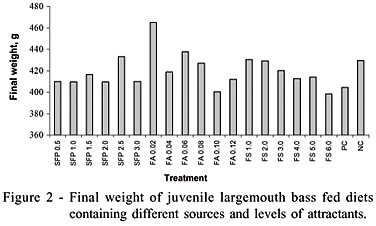Adding attractants can improve acceptability of artificial diets by carnivorous fish fry and fingerlings, increasing intake of unpalatable feeds and improving growth rate, while reducing feeding time and feeding wastes. This study aimed to evaluate the effects of levels of inclusion of different attractants in plant protein-based diets on the performance of largemouth bass Micropterus salmoides. Nine hundred juvenile largemouth bass (26.54 ± 1.53 g) conditioned to accept dry, artificial feed were stocked in 60, 90-L polyethylene tanks (15 fish per group) in a completely randomized design trial (n=3). Fish were fed two daily meals ad libitum at 7h00 and 17h00, for 13 days, with a diet (100% plant protein source) containing either soluble fish protein - SFP (0.5, 1.0, 1.5, 2.0, 2.5, and 3.0%); FisharonTM - FA (0.02, 0.04, 0.06, 0.08, 0.10, 0.12%); fish silage - FS (1.0, 2.0, 3.0, 4.0, 5.0, and 6.0%); a positive control diet - pCD (10% fish meal) and a negative control diet - nCD (basal diet without attractants). DL-methionine (98%) and L-lysine (80%) were added automatically by the formulation software to adjust available amino-acid profile of diets. Recorded performance data were: final weight, feed intake, weight gain and feed conversion ratio. Fish fed diet FA0.02 presented the best growth rate, best weight gain and best feed conversion ratio. Fish fed diets containing FS as attractant presented the poorest performance.
feeding attractants; palatability; carnivorous fish







